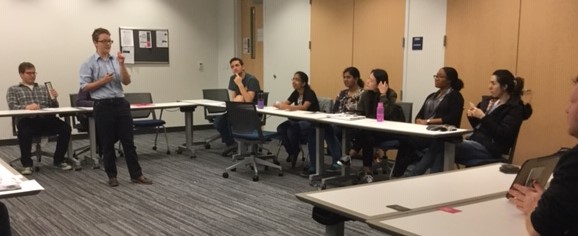Adding Improv to Let’s Talk: Science Edition
Hours
| Fall & Spring Semester Semester | |
| Monday-Thursday: | 10am-7pm |
| Friday: | 9-12noon |
| Saturday: | closed |
| Sunday: | 4pm-8pm |
Adding Improv to Let’s Talk: Science Edition

The following sessions introduced an improv game called Debate Club from The Metagame box set. Debate Club is a typical party game; it provides a series of topic and opinion cards designed to stimulate conversation among a group of people. For our use, one participant would volunteer to be a judge and select an opinion card for the debate. The other participants were considered the debaters. Each debater would select five topic cards and then select from them, the one topic that best related to the opinion card and that they could best argue for. Then, each participant would stand up in front of the room and argue their case. As participants spoke, Williams and Cuny began to notice new elements of participants public speaking skills, such as audience engagement, movement around the room, vocal inflection, nonverbal confidence, and illustrative hand gestures. Since this debate game was silly in nature, we began to see less stiff speakers and more fluid speakers. Initially, speakers seemed confined to their original seated position with tense body posture. They demonstrated rigid movement, such as hand gestures that were out of sync with their verbal messages or a shift in their body’s position that signaled mild distress. Eye contact was restricted due to a tendency to stare at the topic card while speaking. Also, verbal messages lacked the components of an introduction and conclusion. It was not long before a speaker broke this persona of stiffness by placing the topic card face down on the desk and standing up. In addition, the speaker led into the argument with an amusing and relatable story that connected the topic card to the opinion card. This change in delivery seemed to make an impression because the next speaker further expressed fluidity by walking around the room and engaging in purposeful eye contact while delivering their argument. This chain reaction effect between the first and second speaker seemed to encourage other participants to execute more fluid, and sometimes silly, delivery behaviors. Speakers even began to modulate their vocal delivery in an attempt to increase the persuasiveness of their argument. Due to the impact of this game on the participants, it was used as a warm-up activity before main speaking activities going forward.
This is part of The University Speaking Center at UNC Greensboro’s archival account of communicating science pedagogy developed and/or facilitated by Kim Cuny, Erin Harrison, Taylor, Williams, Jenny Southard, and Miranda Tonkins. Most of these interventions were funded by a UNC Greensboro INNOVATE grant.





